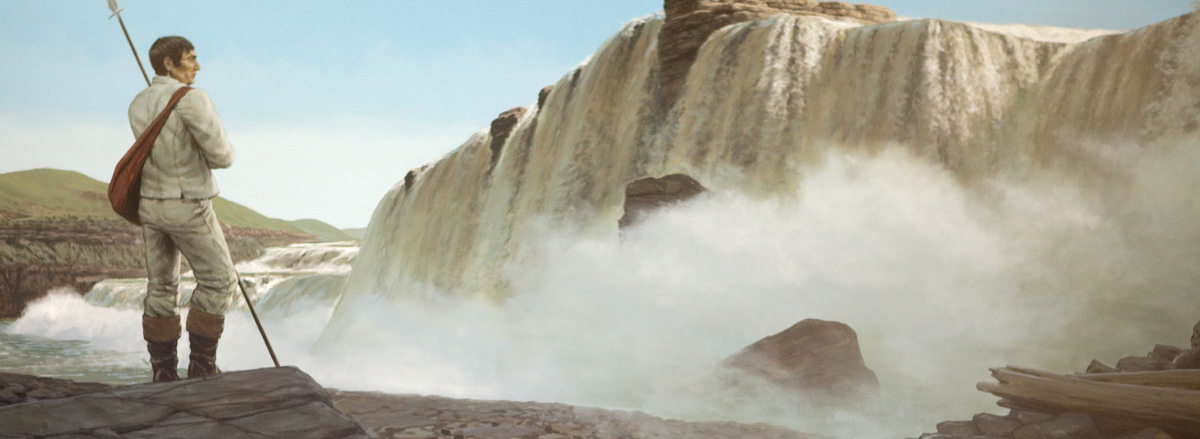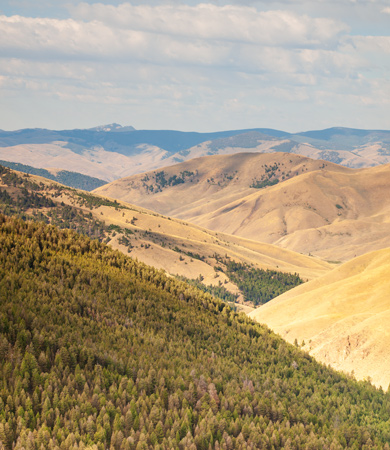In Synopsis Part 3, they struggle to get their canoes around the Great Falls of the Missouri and find the Lemhi Shoshones and their horses.
The Falls of the Missouri
If they found it, one landmark would cinch the argument—the Great Falls of the Missouri. To assure the doubting troopers that they were indeed on the right course, and to arrive quickly at a final resolution, Meriwether Lewis decided to march overland. Pausing again to view the august if formidable spectacle of the Rocky Mountains, he passed over “a most beautiful and level plain” with “infinitely more buffaloe than I had ever before witnessed.” In two days he arrived at the “sublimely grand specticle” of the falls.
Once again his poetic nature emerged. For two hours he sat on a rock overlooking the grandest sight he had ever beheld, and wrote at length of “the beauty of this majestically grand scenery.” Even then he felt that he could not do justice to “this truly magnifficent and sublimely grand object, which has from the commencement of time been concealed from the view of civilized man.” No small part of his rapture was derived from the certain knowledge that his decision at the Marias had been right.
The Great Portage
Lewis arrived at the falls on 13 June 1805, anticipating an easy, one-day portage. The following day his initial amazement was compounded by the discovery of our more waterfalls. Then came the reality: The portage route would be 18 miles long! Nearly one month of the Montana summer was to be occupied in transporting the canoes and equipment from Belt Creek, northeast of the falls, across rugged terrain to the upper portage camp east of three islands they named White Bear Islands. They were pummeled by storms of wind, rain and hail, tortured by prickly pear cactus, plagued by rattlesnakes and mosquitoes, and menaced by “white” bears—grizzly bears. William Clark called it the most perilous and difficult part of their voyage. The only consolation was the abundance of buffalo nearby, ten thousand of them, at least.
The Iron-framed Boat
The big white pirogue, too heavy to be portaged, was left behind. Anticipating such a circumstance, Lewis had designed and brought along the iron-framed boat, a portable strap-iron framework for a boat that could be covered with animal hides and sealed with pine pitch. Unfortunately, there were no pine trees in the vicinity of the White Bear Islands, and the improvised caulking of pounded charcoal and buffalo tallow didn’t work. The boat sank; Lewis’s “experiment” was a failure, and another five days were spent hewing two cottonwood dugouts to replace it. After digging several caches to conceal some excess baggage, including specimens of the new plants Lewis had found along the Missouri, the Corps of Discovery got underway again on 15 July 1805. They were less than 100-miles upstream from the Marias River, which they had left on 23 June 1805.
The Rocky Mountains
Upper Reaches of the Missouri River
The captains were worried. The expedition was quickly running out of time and space: time to cross the Rockies before winter, and space to find the Shoshones, with their horses and guides. But another month of increasingly toilsome river travel would ensue before either was assured. Despite being the better boatman, Clark walked cross-country most of the time now, hoping to encounter the Indians before the guns of his hunters frightened them off. He saw distant smoke and other recent signs, but no Shoshones.
Steadily but painfully, Lewis brought the main party upstream, past the tributaries he named for Secretary of the Navy Robert Smith and Secretary of War Henry Dearborn.
Navigating the gap he called the Gates of the Mountains, north of modern Helena, his description of the “remarkable clifts” matched his mental outlook.
“Every object here,” he wrote, “wears a dark and gloomy aspect.” His spirits brightened when Sacagawea began recognizing the country, and assured him that her people were not far ahead. Finally, on 27 July 1805, the river party joined Clark’s advance guard at another essential point in the geography of the west, the Three Forks of the Missouri. In twelve days they’d made 190 miles.
Both Lewis and Clark reconnoitered the three rivers; their decision to pursue the Jefferson stemmed from the direction of its flow, and from Sacagawea’s memories. Desperate, Lewis forged ahead with three picked companions, interpreter George Drouillard, Private John Shields, and Private Hugh McNeal. He was determined to find the Shoshone.
Over the Continental Divide
Westward View from Lemhi Pass
Photo © 9 September 2008 by Kristopher K. Townsend. Permission to use granted under the Creative Commons Attribution-Share Alike 4.0 International license.
See also Lemhi Pass
Lewis continued up the Beaverhead River and turned west toward the divide at Horse Prairie Creek, south of today’s Dillon, Montana. Marching up the gradual slope on the morning of 11 August 1805, with Drouillard and Shields as flankers, Lewis spotted a lone Indian on horseback, the first Indian they had seen since leaving Fort Mandan. Unfortunately, the flankers spooked the horseman, and he galloped off.
On the next day, Lewis went over the Continental Divide. McNeal had straddled the uppermost streamlet and thanked God he had “lived to bestride the mighty & heretofore deemed endless Missouri,” and Lewis drank deeply from “the most distant fountain” that provided its waters.
Descending steeply into the upper Lemhi valley and river, one of the headwaters of the Columbia River, Lewis encountered a Shoshoni woman and two girls who led him to their village and introduced him to their chief, Cameahwait, who welcomed him cordially. Lewis persuaded the Shoshoni to accompany him back to the the expedition’s “Fortunate Camp” on the Beaverhead River, where Clark and the main party were expected to arrive. There, after some tense moments of mutual apprehension and distrust, friendship was reconfirmed.


